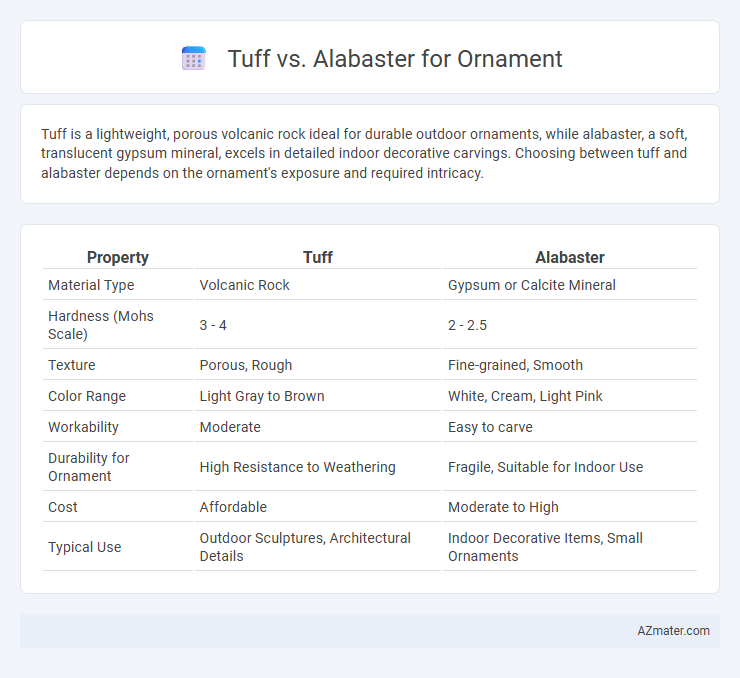Tuff is a lightweight, porous volcanic rock ideal for durable outdoor ornaments, while alabaster, a soft, translucent gypsum mineral, excels in detailed indoor decorative carvings. Choosing between tuff and alabaster depends on the ornament's exposure and required intricacy.
Table of Comparison
| Property | Tuff | Alabaster |
|---|---|---|
| Material Type | Volcanic Rock | Gypsum or Calcite Mineral |
| Hardness (Mohs Scale) | 3 - 4 | 2 - 2.5 |
| Texture | Porous, Rough | Fine-grained, Smooth |
| Color Range | Light Gray to Brown | White, Cream, Light Pink |
| Workability | Moderate | Easy to carve |
| Durability for Ornament | High Resistance to Weathering | Fragile, Suitable for Indoor Use |
| Cost | Affordable | Moderate to High |
| Typical Use | Outdoor Sculptures, Architectural Details | Indoor Decorative Items, Small Ornaments |
Introduction to Tuff and Alabaster
Tuff, a volcanic rock formed from consolidated ash, offers lightweight durability and easy carvability, making it suitable for detailed ornaments. Alabaster, a fine-grained, soft gypsum or calcite stone, is prized for its translucent, smooth texture and ability to capture intricate designs with a polished finish. Both materials provide distinct aesthetic and functional properties, influencing their choice in ornamental artistry.
Geological Formation and Composition
Tuff is an igneous rock formed from volcanic ash ejected during explosive eruptions, primarily composed of consolidated volcanic ash and small fragments of minerals and rocks. Alabaster is a sedimentary rock, usually formed through the evaporation of mineral-rich waters, mainly composed of gypsum or calcite, giving it a fine-grained, translucent quality ideal for detailed carving. The distinct geological formation processes result in tuff being more porous and less durable, while alabaster's compact crystalline structure provides a smooth surface preferred for ornamental art.
Physical Properties Comparison
Tuff is a porous volcanic rock characterized by low density and moderate hardness, making it lightweight and easy to carve for ornaments. Alabaster, a fine-grained gypsum or calcite mineral, features a smooth texture, higher translucency, and greater softness, allowing for intricate detailing but less durability. Comparing compressive strength, Alabaster typically exhibits lower resistance to abrasion than the more durable, albeit coarser, Tuff, influencing their suitability in ornamental applications exposed to varying environmental conditions.
Color and Aesthetic Appeal
Tuff offers a rugged, earthy palette with shades ranging from muted grays to soft browns, creating a naturally textured and rustic aesthetic ideal for ornaments seeking a raw, organic look. Alabaster boasts a smooth, translucent white appearance that imparts a refined, elegant charm, making it perfect for ornaments that demand a classic, sophisticated appeal. The choice between Tuff and Alabaster hinges on desired color depth and surface finish, with Tuff favoring more natural, matte tones and Alabaster providing bright, polished luminosity.
Workability and Carving Ease
Tuff is prized for its excellent workability due to its soft, porous structure, making it easier to carve intricate details with hand tools compared to the denser, harder Alabaster. Alabaster, while slightly harder, offers a smooth, fine-grained texture that allows for polished finishes but requires more skill and effort to achieve detailed carving. Sculptors often prefer tuff for complex, delicate designs, whereas alabaster is favored for elegant, refined ornaments where a glossy surface is desired.
Durability and Long-Term Performance
Tuff offers superior durability with high resistance to weathering, making it ideal for outdoor ornaments exposed to harsh conditions. Alabaster, while visually appealing with its smooth texture, is more susceptible to scratches and environmental wear, reducing its long-term performance. Choosing Tuff ensures sustained structural integrity and minimal maintenance for ornamental applications.
Weather Resistance and Maintenance
Tuff offers superior weather resistance compared to Alabaster, with enhanced durability against moisture, UV exposure, and temperature fluctuations, making it ideal for outdoor ornaments. Alabaster is more porous and susceptible to erosion and discoloration when exposed to harsh weather, requiring more frequent maintenance and protective sealants. Maintenance for Tuff is minimal, often limited to occasional cleaning, while Alabaster demands regular upkeep to preserve its appearance and structural integrity.
Common Uses in Ornamentation
Tuff and alabaster are popular materials in ornamentation, with tuff commonly used for architectural elements like garden sculptures and ornamental facades due to its lightweight and porous nature. Alabaster, prized for its smooth texture and translucency, is frequently carved into intricate indoor decorative objects such as vases, lamps, and figurines. Both materials offer unique aesthetic qualities, with tuff providing durability for outdoor use and alabaster lending elegance to interior art pieces.
Cost and Availability
Tuff is generally more affordable than alabaster due to its widespread availability and abundant natural deposits. Alabaster, being rarer and often sourced from specific quarries, tends to have higher costs and limited accessibility in certain regions. The cost-effectiveness and easy procurement of tuff make it a popular choice for ornamental use compared to the premium pricing and scarcity of alabaster.
Choosing the Right Stone for Your Ornament
Tuff and alabaster are popular choices for ornamental stone, each offering distinct qualities for different artistic needs. Tuff, a volcanic rock, provides durability and a rough texture ideal for outdoor sculptures, while alabaster's smooth, translucent surface allows for detailed carving and indoor decorative pieces. Selecting the right stone depends on the ornament's intended location, desired texture, and longevity requirements.

Infographic: Tuff vs Alabaster for Ornament
 azmater.com
azmater.com